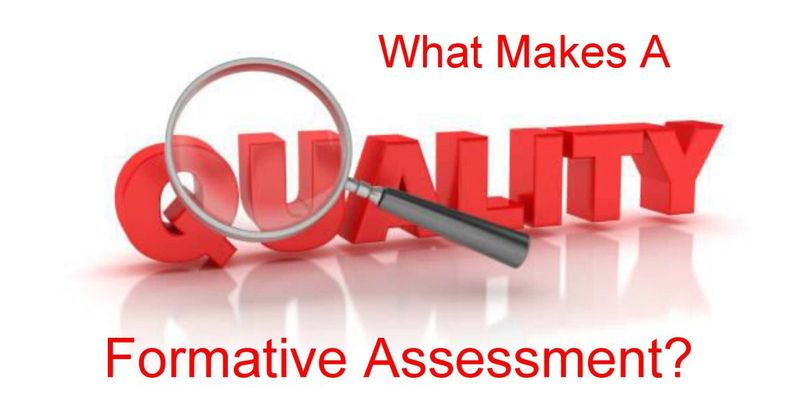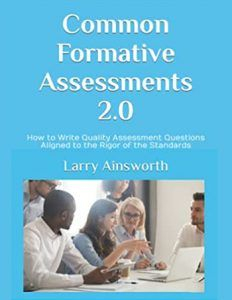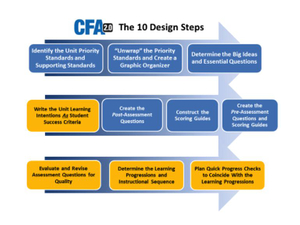Date of Blog Post: March 29, 2022
Newly Republished on Amazon KDP! Common Formative Assessments 2.0: How to Write Quality Assessment Questions Aligned to the Rigor of the Standards for In-Depth Instruction and Assessment (Ainsworth, 2021)
ENDORSEMENT BY JOHN HATTIE:
“Ainsworth spells out how classroom teachers can work together to create formative assessments in order to monitor student learning and adapt teaching. The new material in this book is critical: Ainsworth introduces constructive alignment of learning outcomes, standards, success criteria, and classroom and larger-scale assessments. He emphasizes the quality of assessments to enable excellent diagnostic interpretations of data. He does not ask teachers to do all this alone, but as a community of experts led by instructional leaders (the chapter on PLCs in itself is worth buying the book). He does all of this with the intention of maximizing our positive impact on student learning. There have been many who have written about the power of success criteria, growth and progress, and assessment for teachers, but not how to do it.
Ainsworth spells it out to perfection…Changing this thinking is the power of this book.”
—John Hattie
Professor of Education and Director of the Melbourne Education Research Institute
University of Melbourne, Australia
****************************************************************************
WHAT ARE CFAs?
Common formative assessments (CFAs) are assessments for learning that are collaboratively designed by a grade- or course-level team of educators to assess student understanding of the particular standards currently in focus within a series of related lessons or a curricular unit of study. Yet this step-by-step design process is not limited to collaborative teams only; it works equally well for individual classroom teachers working on their own.
CFAs typically include a blend of assessment formats: selected response, (students select their answer choice from provided responses), constructed response (short- and extended-answer), and Essential Questions requiring students’ Big Idea responses. This multiple-format assessment makes learning more visible because it gives students more than one way to “show all they know” about what they have learned.
CFAs afford grade- and course-level teacher teams (and individuals) a clear lens through which to see their instructional impact on student learning. The assessment questions directly match the levels of cognitive rigor of the academic content standards in focus. In this way, student responses provide credible assessment evidence of student learning of those standards.
SUMMARY OF CFA 2.0 DESIGN STEPS
Each chapter describes–with illustrative examples–the step-by-step design sequence shown in the above graphic. Here is a synopsis of each of those ten steps:
Step 1: Identify within any content area the particular Priority Standards to emphasize in an upcoming series of lessons or unit of study. Identify other related standards—referred to as supporting standards—that connect to the Priority Standards.
Step 2: “Unwrap” the Priority Standards to pinpoint the specific concepts and skills students need to learn and then create a graphic organizer that includes those “unwrapped” concepts and skills.
Step 3: Determine Big Ideas—based on the “unwrapped” Priority Standards—that represent the connections or conclusions teachers want students to discover on their own. Write Essential Questions matched to the Big Ideas to focus instruction throughout the lessons and/or unit. The goal is for students to be able to respond to the teacher’s Essential Questions with their own worded Big Ideas.
Step 4: Confirm the learning intentions (learning targets) to be assessed—the specifics of what students are to understand and be able to do, and the success criteria—how students will show they have achieved the learning intentions.
Step 5: Select the assessment types (selected-response, short- and extended-response) that will produce credible evidence that students have learned the “unwrapped” concepts and skills. Write or select the post-assessment questions directly aligned to the “unwrapped” Priority Standards.
Step 6: Write the scoring guides for the constructed-response questions (short and extended).
Step 7: Create the pre-assessment questions to align with the post-assessment ones.
Step 8: Evaluate and revise assessment questions for quality using established guidelines BEFORE administering the assessment to students. This ensures that the interpretations or conclusions educators make from student responses are accurate.
Step 9: Determine the learning progressions—the building blocks of daily instruction that lead students to achieving the learning intentions.
Step 10: Plan quick progress checks to assess student understanding of each learning progression in order to make adjustments in instruction and close any student learning gaps.
KEY BENEFITS OF CFAS
- The CFA 2.0 process is not about assessment design only. Rather, it is a system of intentionally aligned components (standards, instruction, and assessments) that all work together to improve student learning.
- Teachers, meeting in teams or working independently, use the resulting student responses as diagnostic feedback to correctly interpret student understanding and to adjust follow-up instruction. Students use the same valuable feedback to monitor and adjust their individual learning strategies.
- Educators often write their CFA questions to reflect the formats of state assessments so students have ongoing opportunities to demonstrate what they are learning in the ways they will be expected to respond on standardized achievement tests.
- Educators find great value in collaboratively scoring the CFAs, discussing the results, and planning ways to achieve improvements in student learning on the next common formative assessment they administer.
- Common formative assessments can do what large-scale summative assessments, by design, cannot—provide classroom educators with timely, credible evidence of their impact on student learning and achievement. Focusing energy and time on the analysis of small-scale, school-based assessments to improve instruction is sure to help educators meet the diverse learning needs of all students.
Thanks for reading! If this is a topic of relevance for you, your school, and/or school district, here again is the Amazon link to the book: Common Formative Assessments 2.0: How to Write Quality Assessment Questions Aligned to the Rigor of the Standards (“Timeless” Practices to Improve Teaching & Learning): Ainsworth, Larry, Viegut, Donald: 9798760058232: Amazon.com: Books
If you’d like to know about the Common Formative Assessments 2.0 virtual workshop, please click here and/or email Larry at larry@larryainsworth.com.



